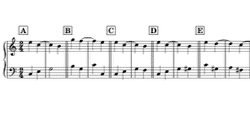In this essay, I will deal with the non-chord note labelled a suspension.
A suspension is an on-beat dissonance —i.e. a metrically strong note that doesn’t belong to the regular chord. It is prepared by a consonance of a different chord —the usual procedure— or by a dissonance of a different chord—less common— and usually resolves down by step to a consonance.
This essay explains in detail the characteristics of a suspension and its different types.
Note that,
- for suspensions that occur in an upper voice, the figures refer to the intervals between that upper voice and the bass
- for suspensions that occur in the bass, the figures refer to the intervals between the bass and the upper voice that creates the dissonance with the bass.
In the musical examples of this essay, I am using the following colour code:
- Red: questionable voice leading
- Orange: voice leading that is more or less/almost okay.
This essay complements my essays Suspensions in the Upper Voice(s) and Suspensions in the Bass from the category Partimento Theory.
A suspension is characterized by three successive elements:
1/ the preparation
- usually occurs on a metrically weaker beat or part of a beat than that of the suspension
- can be either consonant (usually) or dissonant (occasionally)
2/ the suspension
- usually occurs on a metrically stronger beat or part of a beat
- may or may not be tied to the preparation
- is always dissonant
- may be embellished
3/ the resolution
- usually occurs on a metrically weaker beat or part of a beat than that of the suspension
- usually occurs a step below the suspension (although some suspensions resolve up by step to a consonance)
- is usually consonant but can occasionally be dissonant.
The type of suspension largely depends on the type of chord in which it occurs.
Suspensions of a Triad
A triad can include two types of suspensions in the upper voices, which can occur individually or simultaneously:
- the 4–3 suspension
- the 9–8 suspension
There is also the possibility to suspend the root in the bass.
The 4–3 Suspension in an Upper Voice
A 4–3 suspension temporarily replaces the third of a triad with a fourth. It therefore occurs only in an upper voice.

Some observations:
- a 4–3 suspension can be prepared by either a consonance (examples A, C and D) or a dissonance (examples B and E)
- the resolution can occur above the same bass note (examples A and E (second resolution)) or above the same bass note an octave higher or lower (example B)
- the resolution can occur in the context of a new sonority/chord (examples D and E (first resolution))
- the resolution can become a new dissonance (example E (first resolution)) and/or be part of a vertical dissonant interval (examples C and E (first resolution))
In the examples above, 4 resolves directly to 3. However, 4 can also resolve indirectly to 3 via 2:

In this case, the preparation can be as short as an eighth note:

The reason is that although the suspensions still resolve on the next quarter note, their actual rhythmic value is only an eighth note.
The 9–8 Suspension in an Upper Voice
A 9–8 suspension temporarily replaces the octave —i.e. the doubled bass note— of a triad with a ninth. It therefore occurs only in an upper voice.

Some observations:
- a 9–8 suspension is always prepared by a consonance
- the resolution can occur above the same bass note (examples A) or above the same bass note an octave higher or lower (example B)
- the resolution can occur in the context of a new sonority/chord (examples C and D)
- the resolution can become a new dissonance (example D)
This type of suspension is less suited for two-part settings because of the absence of the third:

This imperfection can be remedied by changing the bass at the moment of resolution that the vertical interval is a third, sixth or diminished fourth:

As the name betrays, 9 should occur (at least) a ninth higher than the bass.

Even if there are solutions to avoid a voice-leading progression where a vertical second progresses to a unison (example B), it is considered not ideal.
In the examples above, 9 resolves directly to 8. However, 9 can also resolve indirectly to 8 via 5 or 7:

The 9–8/4–3 Suspensions in Two Upper Voices
The 4–3 and 9–8 suspensions can also occur simultaneously in two upper voices:

As the example above illustrates, any suspension can occur in the top voice or in the inner voice.
Example D is typical of the galant style, with a legitimate cross-relation between f(♮)2 in the top voice on beat 1 of bar 2 and f♯ in the bass on beat 2.
The 9–8/4–3 suspensions can also both resolve indirectly. In this case, only 7 can occur between 9 and 8 (5 is not an option).

One can also choose to embellish only the 9–8 suspension. In that case, both 5 and 7 are excellent options:

The 2–3 Suspension in the Bass
A 2–3 suspension in the bass temporarily replaces the root of a triad with a second, creating an implied 4/2 sonority.

The example above proposes several 2–3 suspensions in the bass in a two-part setting. If one intends to use such a suspension in a three-part setting, one should be careful not to write/play the resolution of the suspension simultaneously with the bass in an upper voice.

If a 2–3 suspension occurs in the bass in a three-part setting, the fifth of the triad must be present at the moment of dissonance:

Notice the melodic progression in orange in the example above. While this voice leading isn’t ideal —the leading note doesn’t rise, it is necessary. It ensures that the fifth of the triad is present at the moment of dissonance.
As is the case with a 9–8 suspension, a 2–3 suspension in the bass can be embellished by inserting a descending third or fifth between the suspension and its resolution:

Suspensions of a Sixth Chord
A sixth chord can include only type of suspension in an upper voice: the 7–6 suspension.
There is also the possibility to suspend the bass note.
The 7–6 Suspension in an Upper Voice
Unlike the triad, the sixth chord allows only one type of regular suspension: the one where the sixth is delayed by the seventh:

As is the case with a 9–8 suspension, a 7–6 suspension of a sixth chord can be embellished by inserting a descending third or fifth between the suspension and its resolution:

Notice that, regarding example
- A, the embellishment of the suspension needs to be chromatically raised (c♯2)
- B, the ornamental descending melodic fifth has become a rising fourth
- C, changing the ornamental descending melodic fifth into a rising fourth is not recommended because the fourth would be augmented.
The 2–3 Suspension in the Bass
A 2–3 suspension in the bass temporarily replaces the bass note of a sixth chord with the note one step higher, creating a 5/2 sonority:

Because the dissonance arises from the clash with the third of the sixth chord, which becomes a second at the moment of dissonance, it is preferable in a two-part setting to the sixth, which becomes a fifth at the moment of dissonance:

